Obserive the anatamical diagrams of Nerium and Nymphaea leaf. Compare the anatamical features and justify their habitat.

Nerium
(i) Thick cuticle and mutilayered eppidermis
(ii) Thick walled sclerenchyma and few spongy parachyma are senn in cortex .
(ii) Well developed vascular tissues.
(iv) Stomata are sunken.
The above mentioned characters prove that Nerium is a xetrophyte
Nymphaea
(i) Cuticel poorly developed
(ii) Excessive development of paranchyma and aerenchyma is cortex
(iii) Poorly developed vascular tissues.
Stomata are completely absent.
The characters mentioned above indicate that Nymphaea is ahydrophyte.
Topper's Solved these Questions
- ORGANISMS AND POPULATIONS BOOK - NEW JOYTHI PUBLICATIONCHAPTER - ORGANISMS AND POPULATIONS EXERCISE - Questin from Previous HSE
11 Videos
- ORGANISMS AND POPULATIONS BOOK - NEW JOYTHI PUBLICATIONCHAPTER - ORGANISMS AND POPULATIONS EXERCISE - Previous Entrance Exam Corner
27 Videos
- ORGANISMS AND POPULATIONS BOOK - NEW JOYTHI PUBLICATIONCHAPTER - ORGANISMS AND POPULATIONS EXERCISE - New Evaluation Types Question
27 Videos
- MOLECULAR BASIS OF INHERITANCEBOOK - NEW JOYTHI PUBLICATIONCHAPTER - MOLECULAR BASIS OF INHERITANCEEXERCISE - PREVIOUS YEAR COMPETITIVE EXAM QUESTIONS
72 Videos
- PRINCIPLES OF INHERITANCE AND VARIATION BOOK - NEW JOYTHI PUBLICATIONCHAPTER - PRINCIPLES OF INHERITANCE AND VARIATION EXERCISE - PREVIOUS YEAR COMPETITIVE EXAM QUESTIONS
72 Videos
Similar Questions
The diagram given below represents a structure found In a leaf.
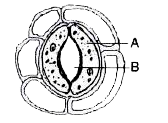
Study the same and answer the questions that follow:
Mention two structural features of A, which help in the function labelled in A above
View SolutionWhen it comes to energy, everyone loves efficiency. Cutting energy waste is one of those goals that both sides of the political divide can agree on, Line even it they sometimes diverge on how best to get 5 there. Energy efficiency allows us to get more out of our given resources, which is good for the economy and (mostly) good for the environment as well. In an increasingly hot and crowded world, the only sustainable way to live is to get more out of less. to Every environmentalist would agree. But change the conversation to food, and suddenly efficiency doesn't look so good. Conventional industrial agriculture has become incredibly efficient on a simple land to kind basis. Is Thanks to fertilizers, mechanization and irrigation, each American farmer feeds over 155 people worldwide. Conventional farming gets more and more crop per square foot of cultivated land—over 170 bushels of corn per acre in Iowa, for 20 example—which can mean less territory needs to be converted from wilderness to farmland. And since a third of the planet is already used for agriculture—destroying forests and oilier wild habitats along the way--anything that help us produce more food on less land would seem to he good for the environment.Of course,that’s not how most environmentalists regard their a rugul a[a leaf ygreen].They have embraced organic food as better for the planet—and healthier and tastier,too—than the stuff produced by agricultural corporations.Environmentalists disdain the enormous amounts of energy needed and waste created by conventional farming,while organic practices—for go in gartificial fertilizers and chemical pesticides—are considered far more sustainable. Sales of organic food ros e7.7% in 2010,upto $26.7 billion—and people are making those purchases for their consciences as much as their taste buds. Yet a new meta-analysis in Nature does the math and comes to a hard conclusion:organic farming yields 25% fewer crops on a verage than conventional agriculture.More land is therefore needed to produce fewer crops—and that means organic farming may not be as good for the planet as we think.
In the Nature analysis, scientists from McGill University in Montreal and the University of Minnesota performed an analysis of 66 studies comparing conventional and organic methods across so 34 different crop species, from fruits to grains to legumes. They found that organic farming delivered a lower yield for every crop type, though the disparity varied widely. For rain-watered legume crops like beans or perennial crops like fruit trees, organic is trailed conventional agriculture by just 5%. Yet for major cereal crops like corn or wheat, as well as most vegetables—all of which provide the bulk of the world's calories—conventional agriculture outperformed organics by more than 25%. 60 The main difference is nitrogen, the chemical key to plant growth. Conventional agriculture makes use of 171 million metric tons of synthetic fertilizer each year, and all that nitrogen enables much faster plant growth than the slower release of nitrogen from the 6S compost or cover crops used in organic farming. When we talk about a Green Revolution, we really mean a nitrogen revolution—along with a lot of water. Rut not all the nitrogen used in conventional /0 fertilizer ends up in crops—much of it ends up running off the soil and into the oceans, creating vast polluted dead zones. We're already putting more nitrogen into the soil than the planet can stand over the long term. And conventional agriculture also is depends heavily on chemical pesticides, which can have unintended side effects.
What that means is that while conventional agriculture is more efficient—sometimes much more efficient—than organic farming, there are trade-offs so with each. So an ideal global agriculture system, in the views of the study's authors, may borrow the best from both systems, as Jonathan Foley of the University of Minnesota explained: The bottom line? Today's organic farming 85 practices are probably best deployed in fruit and vegetable farms, where growing nutrition (not just bulk calories) is the primary goal. But for delivering sheer calories, especially in our staple crops of wheat, rice, maize, soybeans and so on, 90 conventional farms have the advantage right now.
Looking forward, I think we will need to deploy different kinds of practices (especially new, mixed approaches that take the best of organic 95 and conventional farming systems) where they are best suited—geographically, economically, socially, etc.
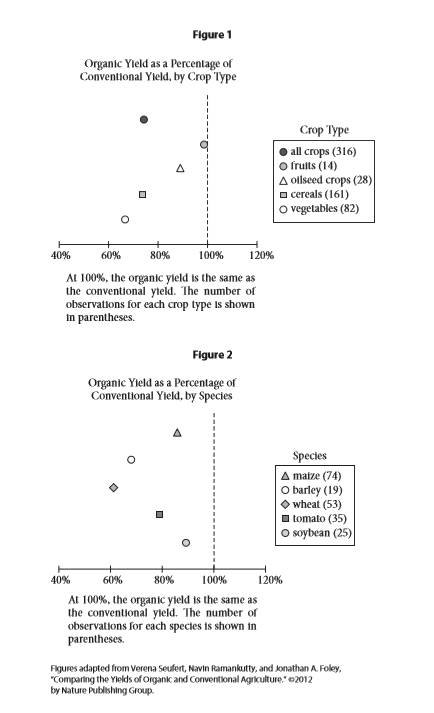
Which choice provides the best evidence for the answer to the previous question
View Solution
Knowledge Check
When it comes to energy, everyone loves efficiency. Cutting energy waste is one of those goals that both sides of the political divide can agree on, Line even it they sometimes diverge on how best to get 5 there. Energy efficiency allows us to get more out of our given resources, which is good for the economy and (mostly) good for the environment as well. In an increasingly hot and crowded world, the only sustainable way to live is to get more out of less. to Every environmentalist would agree. But change the conversation to food, and suddenly efficiency doesn't look so good. Conventional industrial agriculture has become incredibly efficient on a simple land to kind basis. Is Thanks to fertilizers, mechanization and irrigation, each American farmer feeds over 155 people worldwide. Conventional farming gets more and more crop per square foot of cultivated land—over 170 bushels of corn per acre in Iowa, for 20 example—which can mean less territory needs to be converted from wilderness to farmland. And since a third of the planet is already used for agriculture—destroying forests and oilier wild habitats along the way--anything that help us produce more food on less land would seem to he good for the environment.Of course,that’s not how most environmentalists regard their a rugul a[a leaf ygreen].They have embraced organic food as better for the planet—and healthier and tastier,too—than the stuff produced by agricultural corporations.Environmentalists disdain the enormous amounts of energy needed and waste created by conventional farming,while organic practices—for go in gartificial fertilizers and chemical pesticides—are considered far more sustainable. Sales of organic food ros e7.7% in 2010,upto $26.7 billion—and people are making those purchases for their consciences as much as their taste buds. Yet a new meta-analysis in Nature does the math and comes to a hard conclusion:organic farming yields 25% fewer crops on a verage than conventional agriculture.More land is therefore needed to produce fewer crops—and that means organic farming may not be as good for the planet as we think.
In the Nature analysis, scientists from McGill University in Montreal and the University of Minnesota performed an analysis of 66 studies comparing conventional and organic methods across so 34 different crop species, from fruits to grains to legumes. They found that organic farming delivered a lower yield for every crop type, though the disparity varied widely. For rain-watered legume crops like beans or perennial crops like fruit trees, organic is trailed conventional agriculture by just 5%. Yet for major cereal crops like corn or wheat, as well as most vegetables—all of which provide the bulk of the world's calories—conventional agriculture outperformed organics by more than 25%. 60 The main difference is nitrogen, the chemical key to plant growth. Conventional agriculture makes use of 171 million metric tons of synthetic fertilizer each year, and all that nitrogen enables much faster plant growth than the slower release of nitrogen from the 6S compost or cover crops used in organic farming. When we talk about a Green Revolution, we really mean a nitrogen revolution—along with a lot of water. Rut not all the nitrogen used in conventional /0 fertilizer ends up in crops—much of it ends up running off the soil and into the oceans, creating vast polluted dead zones. We're already putting more nitrogen into the soil than the planet can stand over the long term. And conventional agriculture also is depends heavily on chemical pesticides, which can have unintended side effects.
What that means is that while conventional agriculture is more efficient—sometimes much more efficient—than organic farming, there are trade-offs so with each. So an ideal global agriculture system, in the views of the study's authors, may borrow the best from both systems, as Jonathan Foley of the University of Minnesota explained: The bottom line? Today's organic farming 85 practices are probably best deployed in fruit and vegetable farms, where growing nutrition (not just bulk calories) is the primary goal. But for delivering sheer calories, especially in our staple crops of wheat, rice, maize, soybeans and so on, 90 conventional farms have the advantage right now.
Looking forward, I think we will need to deploy different kinds of practices (especially new, mixed approaches that take the best of organic 95 and conventional farming systems) where they are best suited—geographically, economically, socially, etc.
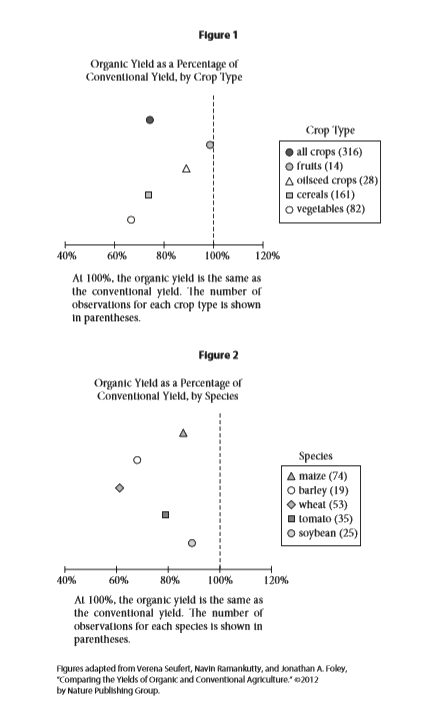
According to the passage,as ignificant attribute of conventional agriculture is its ability toAproduce a wide variety of fruits and vegetablesBmaximize the output of cultivated landCsatisfy the dietary needs of the world's populationDlessen the necessity of nitrogen in plant growth.When it comes to energy, everyone loves efficiency. Cutting energy waste is one of those goals that both sides of the political divide can agree on, Line even it they sometimes diverge on how best to get 5 there. Energy efficiency allows us to get more out of our given resources, which is good for the economy and (mostly) good for the environment as well. In an increasingly hot and crowded world, the only sustainable way to live is to get more out of less. to Every environmentalist would agree. But change the conversation to food, and suddenly efficiency doesn't look so good. Conventional industrial agriculture has become incredibly efficient on a simple land to kind basis. Is Thanks to fertilizers, mechanization and irrigation, each American farmer feeds over 155 people worldwide. Conventional farming gets more and more crop per square foot of cultivated land—over 170 bushels of corn per acre in Iowa, for 20 example—which can mean less territory needs to be converted from wilderness to farmland. And since a third of the planet is already used for agriculture—destroying forests and oilier wild habitats along the way--anything that help us produce more food on less land would seem to he good for the environment.Of course,that’s not how most environmentalists regard their a rugul a[a leaf ygreen].They have embraced organic food as better for the planet—and healthier and tastier,too—than the stuff produced by agricultural corporations.Environmentalists disdain the enormous amounts of energy needed and waste created by conventional farming,while organic practices—for go in gartificial fertilizers and chemical pesticides—are considered far more sustainable. Sales of organic food ros e7.7% in 2010,upto $26.7 billion—and people are making those purchases for their consciences as much as their taste buds. Yet a new meta-analysis in Nature does the math and comes to a hard conclusion:organic farming yields 25% fewer crops on a verage than conventional agriculture.More land is therefore needed to produce fewer crops—and that means organic farming may not be as good for the planet as we think.
In the Nature analysis, scientists from McGill University in Montreal and the University of Minnesota performed an analysis of 66 studies comparing conventional and organic methods across so 34 different crop species, from fruits to grains to legumes. They found that organic farming delivered a lower yield for every crop type, though the disparity varied widely. For rain-watered legume crops like beans or perennial crops like fruit trees, organic is trailed conventional agriculture by just 5%. Yet for major cereal crops like corn or wheat, as well as most vegetables—all of which provide the bulk of the world's calories—conventional agriculture outperformed organics by more than 25%. 60 The main difference is nitrogen, the chemical key to plant growth. Conventional agriculture makes use of 171 million metric tons of synthetic fertilizer each year, and all that nitrogen enables much faster plant growth than the slower release of nitrogen from the 6S compost or cover crops used in organic farming. When we talk about a Green Revolution, we really mean a nitrogen revolution—along with a lot of water. Rut not all the nitrogen used in conventional /0 fertilizer ends up in crops—much of it ends up running off the soil and into the oceans, creating vast polluted dead zones. We're already putting more nitrogen into the soil than the planet can stand over the long term. And conventional agriculture also is depends heavily on chemical pesticides, which can have unintended side effects.
What that means is that while conventional agriculture is more efficient—sometimes much more efficient—than organic farming, there are trade-offs so with each. So an ideal global agriculture system, in the views of the study's authors, may borrow the best from both systems, as Jonathan Foley of the University of Minnesota explained: The bottom line? Today's organic farming 85 practices are probably best deployed in fruit and vegetable farms, where growing nutrition (not just bulk calories) is the primary goal. But for delivering sheer calories, especially in our staple crops of wheat, rice, maize, soybeans and so on, 90 conventional farms have the advantage right now.
Looking forward, I think we will need to deploy different kinds of practices (especially new, mixed approaches that take the best of organic 95 and conventional farming systems) where they are best suited—geographically, economically, socially, etc.
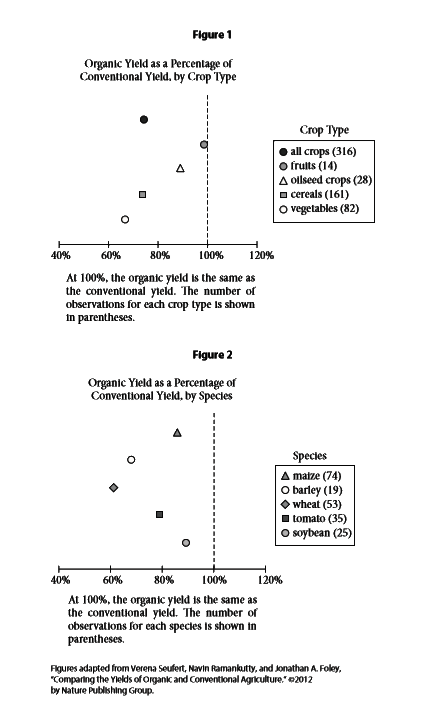
Which of the following claims is supported by figure2?AOf the organically grown species represented, soybeans have the lowest yieldBThe organically grown maize and barley represented are comparable in their yields to conventionally grown maize and barleyCOf the organically grown species represented, tomatoes have the highest yieldDThe organically grown species represented have lower yields than their conventionally grown counter parts doWhen it comes to energy, everyone loves efficiency. Cutting energy waste is one of those goals that both sides of the political divide can agree on, Line even it they sometimes diverge on how best to get 5 there. Energy efficiency allows us to get more out of our given resources, which is good for the economy and (mostly) good for the environment as well. In an increasingly hot and crowded world, the only sustainable way to live is to get more out of less. to Every environmentalist would agree. But change the conversation to food, and suddenly efficiency doesn't look so good. Conventional industrial agriculture has become incredibly efficient on a simple land to kind basis. Is Thanks to fertilizers, mechanization and irrigation, each American farmer feeds over 155 people worldwide. Conventional farming gets more and more crop per square foot of cultivated land—over 170 bushels of corn per acre in Iowa, for 20 example—which can mean less territory needs to be converted from wilderness to farmland. And since a third of the planet is already used for agriculture—destroying forests and oilier wild habitats along the way--anything that help us produce more food on less land would seem to he good for the environment.Of course,that’s not how most environmentalists regard their a rugul a[a leaf ygreen].They have embraced organic food as better for the planet—and healthier and tastier,too—than the stuff produced by agricultural corporations.Environmentalists disdain the enormous amounts of energy needed and waste created by conventional farming,while organic practices—for go in gartificial fertilizers and chemical pesticides—are considered far more sustainable. Sales of organic food ros e7.7% in 2010,upto $26.7 billion—and people are making those purchases for their consciences as much as their taste buds. Yet a new meta-analysis in Nature does the math and comes to a hard conclusion:organic farming yields 25% fewer crops on a verage than conventional agriculture.More land is therefore needed to produce fewer crops—and that means organic farming may not be as good for the planet as we think.
In the Nature analysis, scientists from McGill University in Montreal and the University of Minnesota performed an analysis of 66 studies comparing conventional and organic methods across so 34 different crop species, from fruits to grains to legumes. They found that organic farming delivered a lower yield for every crop type, though the disparity varied widely. For rain-watered legume crops like beans or perennial crops like fruit trees, organic is trailed conventional agriculture by just 5%. Yet for major cereal crops like corn or wheat, as well as most vegetables—all of which provide the bulk of the world's calories—conventional agriculture outperformed organics by more than 25%. 60 The main difference is nitrogen, the chemical key to plant growth. Conventional agriculture makes use of 171 million metric tons of synthetic fertilizer each year, and all that nitrogen enables much faster plant growth than the slower release of nitrogen from the 6S compost or cover crops used in organic farming. When we talk about a Green Revolution, we really mean a nitrogen revolution—along with a lot of water. Rut not all the nitrogen used in conventional /0 fertilizer ends up in crops—much of it ends up running off the soil and into the oceans, creating vast polluted dead zones. We're already putting more nitrogen into the soil than the planet can stand over the long term. And conventional agriculture also is depends heavily on chemical pesticides, which can have unintended side effects.
What that means is that while conventional agriculture is more efficient—sometimes much more efficient—than organic farming, there are trade-offs so with each. So an ideal global agriculture system, in the views of the study's authors, may borrow the best from both systems, as Jonathan Foley of the University of Minnesota explained: The bottom line? Today's organic farming 85 practices are probably best deployed in fruit and vegetable farms, where growing nutrition (not just bulk calories) is the primary goal. But for delivering sheer calories, especially in our staple crops of wheat, rice, maize, soybeans and so on, 90 conventional farms have the advantage right now.
Looking forward, I think we will need to deploy different kinds of practices (especially new, mixed approaches that take the best of organic 95 and conventional farming systems) where they are best suited—geographically, economically, socially, etc.
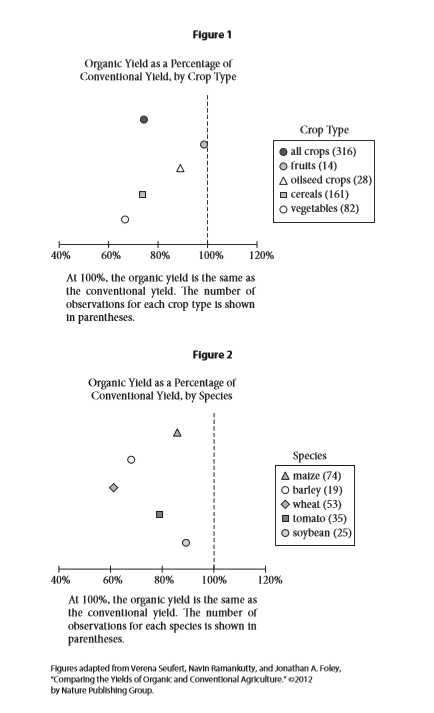
In line88,“sheer”most nearly meansAtransparentBabruptCstreepDpure
When it comes to energy, everyone loves efficiency. Cutting energy waste is one of those goals that both sides of the political divide can agree on, Line even it they sometimes diverge on how best to get 5 there. Energy efficiency allows us to get more out of our given resources, which is good for the economy and (mostly) good for the environment as well. In an increasingly hot and crowded world, the only sustainable way to live is to get more out of less. to Every environmentalist would agree. But change the conversation to food, and suddenly efficiency doesn't look so good. Conventional industrial agriculture has become incredibly efficient on a simple land to kind basis. Is Thanks to fertilizers, mechanization and irrigation, each American farmer feeds over 155 people worldwide. Conventional farming gets more and more crop per square foot of cultivated land—over 170 bushels of corn per acre in Iowa, for 20 example—which can mean less territory needs to be converted from wilderness to farmland. And since a third of the planet is already used for agriculture—destroying forests and oilier wild habitats along the way--anything that help us produce more food on less land would seem to he good for the environment.Of course,that’s not how most environmentalists regard their a rugul a[a leaf ygreen].They have embraced organic food as better for the planet—and healthier and tastier,too—than the stuff produced by agricultural corporations.Environmentalists disdain the enormous amounts of energy needed and waste created by conventional farming,while organic practices—for go in gartificial fertilizers and chemical pesticides—are considered far more sustainable. Sales of organic food ros e7.7% in 2010,upto $26.7 billion—and people are making those purchases for their consciences as much as their taste buds. Yet a new meta-analysis in Nature does the math and comes to a hard conclusion:organic farming yields 25% fewer crops on a verage than conventional agriculture.More land is therefore needed to produce fewer crops—and that means organic farming may not be as good for the planet as we think.
In the Nature analysis, scientists from McGill University in Montreal and the University of Minnesota performed an analysis of 66 studies comparing conventional and organic methods across so 34 different crop species, from fruits to grains to legumes. They found that organic farming delivered a lower yield for every crop type, though the disparity varied widely. For rain-watered legume crops like beans or perennial crops like fruit trees, organic is trailed conventional agriculture by just 5%. Yet for major cereal crops like corn or wheat, as well as most vegetables—all of which provide the bulk of the world's calories—conventional agriculture outperformed organics by more than 25%. 60 The main difference is nitrogen, the chemical key to plant growth. Conventional agriculture makes use of 171 million metric tons of synthetic fertilizer each year, and all that nitrogen enables much faster plant growth than the slower release of nitrogen from the 6S compost or cover crops used in organic farming. When we talk about a Green Revolution, we really mean a nitrogen revolution—along with a lot of water. Rut not all the nitrogen used in conventional /0 fertilizer ends up in crops—much of it ends up running off the soil and into the oceans, creating vast polluted dead zones. We're already putting more nitrogen into the soil than the planet can stand over the long term. And conventional agriculture also is depends heavily on chemical pesticides, which can have unintended side effects.
What that means is that while conventional agriculture is more efficient—sometimes much more efficient—than organic farming, there are trade-offs so with each. So an ideal global agriculture system, in the views of the study's authors, may borrow the best from both systems, as Jonathan Foley of the University of Minnesota explained: The bottom line? Today's organic farming 85 practices are probably best deployed in fruit and vegetable farms, where growing nutrition (not just bulk calories) is the primary goal. But for delivering sheer calories, especially in our staple crops of wheat, rice, maize, soybeans and so on, 90 conventional farms have the advantage right now.
Looking forward, I think we will need to deploy different kinds of practices (especially new, mixed approaches that take the best of organic 95 and conventional farming systems) where they are best suited—geographically, economically, socially, etc.
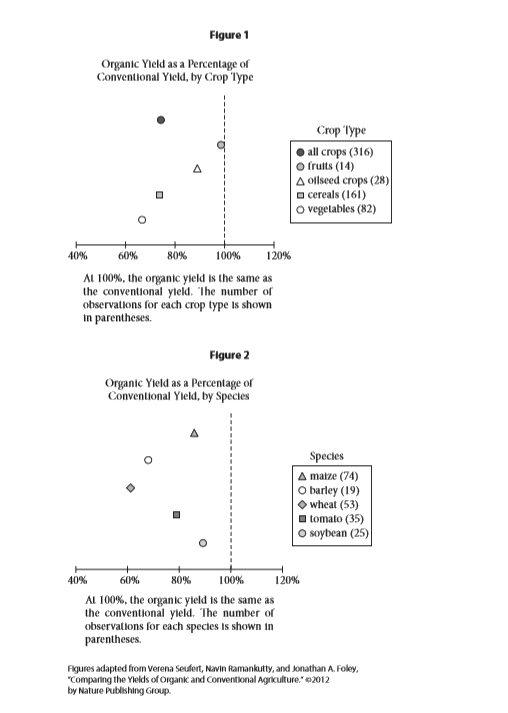
As used in line14,“simple”most nearly means
View SolutionWhen it comes to energy, everyone loves efficiency. Cutting energy waste is one of those goals that both sides of the political divide can agree on, Line even it they sometimes diverge on how best to get 5 there. Energy efficiency allows us to get more out of our given resources, which is good for the economy and (mostly) good for the environment as well. In an increasingly hot and crowded world, the only sustainable way to live is to get more out of less. to Every environmentalist would agree. But change the conversation to food, and suddenly efficiency doesn't look so good. Conventional industrial agriculture has become incredibly efficient on a simple land to kind basis. Is Thanks to fertilizers, mechanization and irrigation, each American farmer feeds over 155 people worldwide. Conventional farming gets more and more crop per square foot of cultivated land—over 170 bushels of corn per acre in Iowa, for 20 example—which can mean less territory needs to be converted from wilderness to farmland. And since a third of the planet is already used for agriculture—destroying forests and oilier wild habitats along the way--anything that help us produce more food on less land would seem to he good for the environment.Of course,that’s not how most environmentalists regard their a rugul a[a leaf ygreen].They have embraced organic food as better for the planet—and healthier and tastier,too—than the stuff produced by agricultural corporations.Environmentalists disdain the enormous amounts of energy needed and waste created by conventional farming,while organic practices—for go in gartificial fertilizers and chemical pesticides—are considered far more sustainable. Sales of organic food ros e7.7% in 2010,upto $26.7 billion—and people are making those purchases for their consciences as much as their taste buds. Yet a new meta-analysis in Nature does the math and comes to a hard conclusion:organic farming yields 25% fewer crops on a verage than conventional agriculture.More land is therefore needed to produce fewer crops—and that means organic farming may not be as good for the planet as we think.
In the Nature analysis, scientists from McGill University in Montreal and the University of Minnesota performed an analysis of 66 studies comparing conventional and organic methods across so 34 different crop species, from fruits to grains to legumes. They found that organic farming delivered a lower yield for every crop type, though the disparity varied widely. For rain-watered legume crops like beans or perennial crops like fruit trees, organic is trailed conventional agriculture by just 5%. Yet for major cereal crops like corn or wheat, as well as most vegetables—all of which provide the bulk of the world's calories—conventional agriculture outperformed organics by more than 25%. 60 The main difference is nitrogen, the chemical key to plant growth. Conventional agriculture makes use of 171 million metric tons of synthetic fertilizer each year, and all that nitrogen enables much faster plant growth than the slower release of nitrogen from the 6S compost or cover crops used in organic farming. When we talk about a Green Revolution, we really mean a nitrogen revolution—along with a lot of water. Rut not all the nitrogen used in conventional /0 fertilizer ends up in crops—much of it ends up running off the soil and into the oceans, creating vast polluted dead zones. We're already putting more nitrogen into the soil than the planet can stand over the long term. And conventional agriculture also is depends heavily on chemical pesticides, which can have unintended side effects.
What that means is that while conventional agriculture is more efficient—sometimes much more efficient—than organic farming, there are trade-offs so with each. So an ideal global agriculture system, in the views of the study's authors, may borrow the best from both systems, as Jonathan Foley of the University of Minnesota explained: The bottom line? Today's organic farming 85 practices are probably best deployed in fruit and vegetable farms, where growing nutrition (not just bulk calories) is the primary goal. But for delivering sheer calories, especially in our staple crops of wheat, rice, maize, soybeans and so on, 90 conventional farms have the advantage right now.
Looking forward, I think we will need to deploy different kinds of practices (especially new, mixed approaches that take the best of organic 95 and conventional farming systems) where they are best suited—geographically, economically, socially, etc.
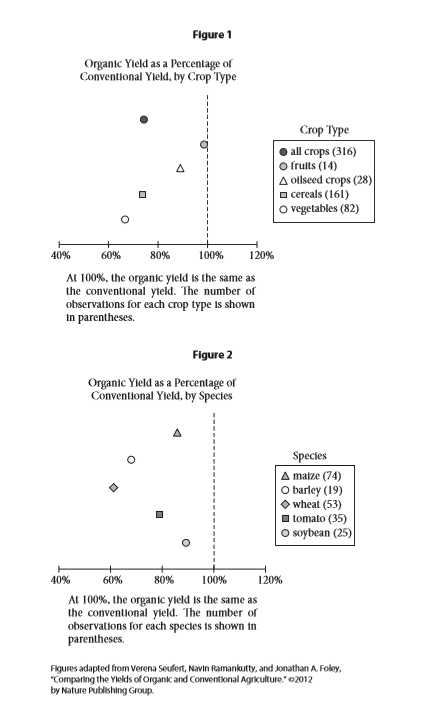
According to Foley,an“ideal global agriculture system”(line80)
View SolutionWhen it comes to energy, everyone loves efficiency. Cutting energy waste is one of those goals that both sides of the political divide can agree on, Line even it they sometimes diverge on how best to get 5 there. Energy efficiency allows us to get more out of our given resources, which is good for the economy and (mostly) good for the environment as well. In an increasingly hot and crowded world, the only sustainable way to live is to get more out of less. to Every environmentalist would agree. But change the conversation to food, and suddenly efficiency doesn't look so good. Conventional industrial agriculture has become incredibly efficient on a simple land to kind basis. Is Thanks to fertilizers, mechanization and irrigation, each American farmer feeds over 155 people worldwide. Conventional farming gets more and more crop per square foot of cultivated land—over 170 bushels of corn per acre in Iowa, for 20 example—which can mean less territory needs to be converted from wilderness to farmland. And since a third of the planet is already used for agriculture—destroying forests and oilier wild habitats along the way--anything that help us produce more food on less land would seem to he good for the environment.Of course,that’s not how most environmentalists regard their a rugul a[a leaf ygreen].They have embraced organic food as better for the planet—and healthier and tastier,too—than the stuff produced by agricultural corporations.Environmentalists disdain the enormous amounts of energy needed and waste created by conventional farming,while organic practices—for go in gartificial fertilizers and chemical pesticides—are considered far more sustainable. Sales of organic food ros e7.7% in 2010,upto $26.7 billion—and people are making those purchases for their consciences as much as their taste buds. Yet a new meta-analysis in Nature does the math and comes to a hard conclusion:organic farming yields 25% fewer crops on a verage than conventional agriculture.More land is therefore needed to produce fewer crops—and that means organic farming may not be as good for the planet as we think.
In the Nature analysis, scientists from McGill University in Montreal and the University of Minnesota performed an analysis of 66 studies comparing conventional and organic methods across so 34 different crop species, from fruits to grains to legumes. They found that organic farming delivered a lower yield for every crop type, though the disparity varied widely. For rain-watered legume crops like beans or perennial crops like fruit trees, organic is trailed conventional agriculture by just 5%. Yet for major cereal crops like corn or wheat, as well as most vegetables—all of which provide the bulk of the world's calories—conventional agriculture outperformed organics by more than 25%. 60 The main difference is nitrogen, the chemical key to plant growth. Conventional agriculture makes use of 171 million metric tons of synthetic fertilizer each year, and all that nitrogen enables much faster plant growth than the slower release of nitrogen from the 6S compost or cover crops used in organic farming. When we talk about a Green Revolution, we really mean a nitrogen revolution—along with a lot of water. Rut not all the nitrogen used in conventional /0 fertilizer ends up in crops—much of it ends up running off the soil and into the oceans, creating vast polluted dead zones. We're already putting more nitrogen into the soil than the planet can stand over the long term. And conventional agriculture also is depends heavily on chemical pesticides, which can have unintended side effects.
What that means is that while conventional agriculture is more efficient—sometimes much more efficient—than organic farming, there are trade-offs so with each. So an ideal global agriculture system, in the views of the study's authors, may borrow the best from both systems, as Jonathan Foley of the University of Minnesota explained: The bottom line? Today's organic farming 85 practices are probably best deployed in fruit and vegetable farms, where growing nutrition (not just bulk calories) is the primary goal. But for delivering sheer calories, especially in our staple crops of wheat, rice, maize, soybeans and so on, 90 conventional farms have the advantage right now.
Looking forward, I think we will need to deploy different kinds of practices (especially new, mixed approaches that take the best of organic 95 and conventional farming systems) where they are best suited—geographically, economically, socially, etc.
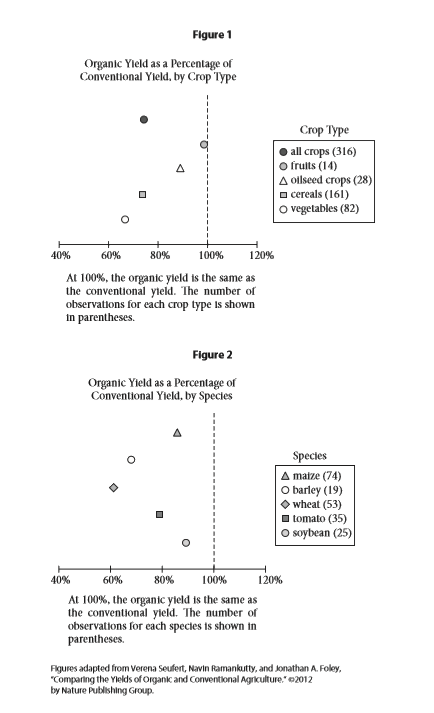
Which statement is best supported by the information provided in figure1
View SolutionWhen it comes to energy, everyone loves efficiency. Cutting energy waste is one of those goals that both sides of the political divide can agree on, Line even it they sometimes diverge on how best to get 5 there. Energy efficiency allows us to get more out of our given resources, which is good for the economy and (mostly) good for the environment as well. In an increasingly hot and crowded world, the only sustainable way to live is to get more out of less. to Every environmentalist would agree. But change the conversation to food, and suddenly efficiency doesn't look so good. Conventional industrial agriculture has become incredibly efficient on a simple land to kind basis. Is Thanks to fertilizers, mechanization and irrigation, each American farmer feeds over 155 people worldwide. Conventional farming gets more and more crop per square foot of cultivated land—over 170 bushels of corn per acre in Iowa, for 20 example—which can mean less territory needs to be converted from wilderness to farmland. And since a third of the planet is already used for agriculture—destroying forests and oilier wild habitats along the way--anything that help us produce more food on less land would seem to he good for the environment.Of course,that’s not how most environmentalists regard their a rugul a[a leaf ygreen].They have embraced organic food as better for the planet—and healthier and tastier,too—than the stuff produced by agricultural corporations.Environmentalists disdain the enormous amounts of energy needed and waste created by conventional farming,while organic practices—for go in gartificial fertilizers and chemical pesticides—are considered far more sustainable. Sales of organic food ros e7.7% in 2010,upto $26.7 billion—and people are making those purchases for their consciences as much as their taste buds. Yet a new meta-analysis in Nature does the math and comes to a hard conclusion:organic farming yields 25% fewer crops on a verage than conventional agriculture.More land is therefore needed to produce fewer crops—and that means organic farming may not be as good for the planet as we think.
In the Nature analysis, scientists from McGill University in Montreal and the University of Minnesota performed an analysis of 66 studies comparing conventional and organic methods across so 34 different crop species, from fruits to grains to legumes. They found that organic farming delivered a lower yield for every crop type, though the disparity varied widely. For rain-watered legume crops like beans or perennial crops like fruit trees, organic is trailed conventional agriculture by just 5%. Yet for major cereal crops like corn or wheat, as well as most vegetables—all of which provide the bulk of the world's calories—conventional agriculture outperformed organics by more than 25%. 60 The main difference is nitrogen, the chemical key to plant growth. Conventional agriculture makes use of 171 million metric tons of synthetic fertilizer each year, and all that nitrogen enables much faster plant growth than the slower release of nitrogen from the 6S compost or cover crops used in organic farming. When we talk about a Green Revolution, we really mean a nitrogen revolution—along with a lot of water. Rut not all the nitrogen used in conventional /0 fertilizer ends up in crops—much of it ends up running off the soil and into the oceans, creating vast polluted dead zones. We're already putting more nitrogen into the soil than the planet can stand over the long term. And conventional agriculture also is depends heavily on chemical pesticides, which can have unintended side effects.
What that means is that while conventional agriculture is more efficient—sometimes much more efficient—than organic farming, there are trade-offs so with each. So an ideal global agriculture system, in the views of the study's authors, may borrow the best from both systems, as Jonathan Foley of the University of Minnesota explained: The bottom line? Today's organic farming 85 practices are probably best deployed in fruit and vegetable farms, where growing nutrition (not just bulk calories) is the primary goal. But for delivering sheer calories, especially in our staple crops of wheat, rice, maize, soybeans and so on, 90 conventional farms have the advantage right now.
Looking forward, I think we will need to deploy different kinds of practices (especially new, mixed approaches that take the best of organic 95 and conventional farming systems) where they are best suited—geographically, economically, socially, etc.
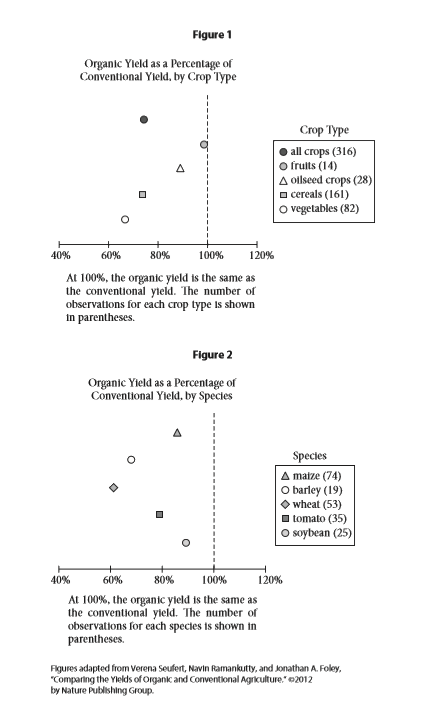
Which choice provides the best evidence for the answer to the previous question
View SolutionWhen it comes to energy, everyone loves efficiency. Cutting energy waste is one of those goals that both sides of the political divide can agree on, Line even it they sometimes diverge on how best to get 5 there. Energy efficiency allows us to get more out of our given resources, which is good for the economy and (mostly) good for the environment as well. In an increasingly hot and crowded world, the only sustainable way to live is to get more out of less. to Every environmentalist would agree. But change the conversation to food, and suddenly efficiency doesn't look so good. Conventional industrial agriculture has become incredibly efficient on a simple land to kind basis. Is Thanks to fertilizers, mechanization and irrigation, each American farmer feeds over 155 people worldwide. Conventional farming gets more and more crop per square foot of cultivated land—over 170 bushels of corn per acre in Iowa, for 20 example—which can mean less territory needs to be converted from wilderness to farmland. And since a third of the planet is already used for agriculture—destroying forests and oilier wild habitats along the way--anything that help us produce more food on less land would seem to he good for the environment.Of course,that’s not how most environmentalists regard their a rugul a[a leaf ygreen].They have embraced organic food as better for the planet—and healthier and tastier,too—than the stuff produced by agricultural corporations.Environmentalists disdain the enormous amounts of energy needed and waste created by conventional farming,while organic practices—for go in gartificial fertilizers and chemical pesticides—are considered far more sustainable. Sales of organic food ros e7.7% in 2010,upto $26.7 billion—and people are making those purchases for their consciences as much as their taste buds. Yet a new meta-analysis in Nature does the math and comes to a hard conclusion:organic farming yields 25% fewer crops on a verage than conventional agriculture.More land is therefore needed to produce fewer crops—and that means organic farming may not be as good for the planet as we think.
In the Nature analysis, scientists from McGill University in Montreal and the University of Minnesota performed an analysis of 66 studies comparing conventional and organic methods across so 34 different crop species, from fruits to grains to legumes. They found that organic farming delivered a lower yield for every crop type, though the disparity varied widely. For rain-watered legume crops like beans or perennial crops like fruit trees, organic is trailed conventional agriculture by just 5%. Yet for major cereal crops like corn or wheat, as well as most vegetables—all of which provide the bulk of the world's calories—conventional agriculture outperformed organics by more than 25%. 60 The main difference is nitrogen, the chemical key to plant growth. Conventional agriculture makes use of 171 million metric tons of synthetic fertilizer each year, and all that nitrogen enables much faster plant growth than the slower release of nitrogen from the 6S compost or cover crops used in organic farming. When we talk about a Green Revolution, we really mean a nitrogen revolution—along with a lot of water. Rut not all the nitrogen used in conventional /0 fertilizer ends up in crops—much of it ends up running off the soil and into the oceans, creating vast polluted dead zones. We're already putting more nitrogen into the soil than the planet can stand over the long term. And conventional agriculture also is depends heavily on chemical pesticides, which can have unintended side effects.
What that means is that while conventional agriculture is more efficient—sometimes much more efficient—than organic farming, there are trade-offs so with each. So an ideal global agriculture system, in the views of the study's authors, may borrow the best from both systems, as Jonathan Foley of the University of Minnesota explained: The bottom line? Today's organic farming 85 practices are probably best deployed in fruit and vegetable farms, where growing nutrition (not just bulk calories) is the primary goal. But for delivering sheer calories, especially in our staple crops of wheat, rice, maize, soybeans and so on, 90 conventional farms have the advantage right now.
Looking forward, I think we will need to deploy different kinds of practices (especially new, mixed approaches that take the best of organic 95 and conventional farming systems) where they are best suited—geographically, economically, socially, etc.
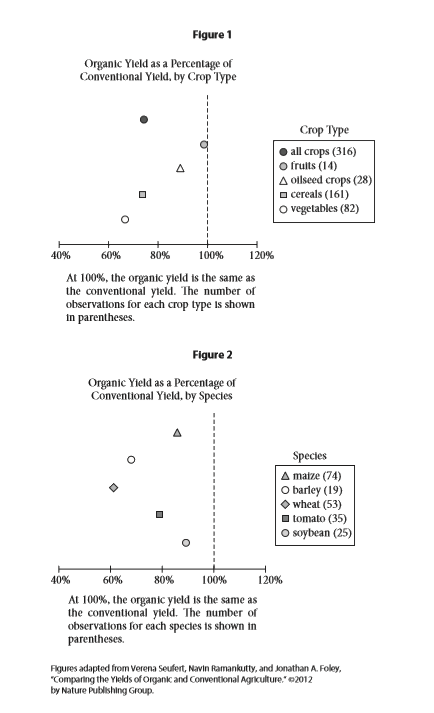
Which statement best expresses a relationship between organic farming and conventional farming that is presented in the passage
View Solution
